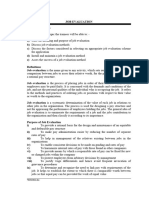RJS Job Evalution
Uploaded by
Ram Janm SinghRJS Job Evalution
Uploaded by
Ram Janm SinghIntroduction to Job Evaluation
Introduction: Once a right candidate is placed on a right
job, the person needs to be duly compensated for the job
he/she performs. In the pursuit of equal payment, there
should be established a consistent and systematic
relationship among base compensation rates for all the
jobs within the organizations. The process of such
establishment is termed “job evaluation”.
Concept and related terminologies of job evaluation: In the area of job
evaluation study, a certain amount of technical terminology is used in order
to facilitate communication. It is therefore desirable to list and understand
allied terms in the job evaluation, as well as some terms that are related to
and often confused with job evaluation.
Position: A position is a group of tasks assigned to one individual. There are
as many positions in a firm as there are personnel.
Job: Edwin B.Flippo describes job as a group of positions that are similar as
to kind and level of work. In some instances only one position may be
involved, simply because no other similar position exists. For example, in
the typical firm the position of human resource manager also constitute a job
since there is only one human resource manager in the organizing.
Job Analysis: It is the process of studying and collecting information
relating to the operations and responsibilities of a specific job. The
immediate products of this analysis are job descriptions and job
specifications.
Motion study: This also involves study of the job. Motions study is one
of the ways of studying job. It is a process of analyzing a job to find the
easiest, most effective, and most economical method of doing it. As
such, motion study is a part of the job design function.
Job description: It is an organized, factual statement of the duties and
responsibilities of a specific job. In brief, it should tell what is to be
done, how it is to be done, and why. It is a standard of function, in that it
defines the appropriate and authorized content of a job.
Job specification: It is a statement of the minimum acceptable human
qualities necessary to perform a job properly. It is a standard of personnel
and designates the qualities required for acceptable performance.
Evaluation: Wigley explains evaluation as a data reduction process that
involves the collection of large amounts of data which are analyzed and
synthesized into an overall judgment of worth or merit. The implication here
is that the judgment of worth can be supported by the data. In her review,
Foxon found similar definitions referring to judgments of value or worth.
Job Evaluation: It is a systematic and orderly process of determining the
worth of a job in relation to other jobs. The objective of this process is to
determine the correct rate of pay. It is therefore not the same as job analysis.
Rather it follows the job analysis process, which provides the basic data to
be evaluated.
In simple worlds, job evaluation is the rating of jobs in an organization. This
is the process establishing the value or worth of jobs in a job hierarchy and
compares the relative intrinsic value or worth of jobs within an organization.
Some renounced definitions of job evaluation are described below.
Scott, Clothier and Priegel defines job evaluation as “the operation of
evaluating a particular job in relation to other jobs either within or outside
the organization”.
Dale Yoder described job evaluation as “a practice which seeks to provide a
degree of objectivity in measuring the comparative value of jobs within an
organization and among similar organizations”.
Edwin B.Flippo defines job evaluation as “a systematic and orderly process
of determining the worth of a job in relation to other jobs”.
Arthur A. Sloane described job evaluation as “any formalized system that
attempts to determine the relative worth of different jobs in the organization
so that jobs of greater value can be rewarded by greater pay”.
According to the International Labor Organization (ILO), “job
evaluation is an attempt to determine and compare the demands which the
normal performance of a particular job makes on normal workers, without
taking into account the individual abilities or performance of the workers
concerned”.
The British Institute of Management defines “job evaluation as the
process of analysis and assessment of jobs to ascertain reliably their
negative worth using the assessment as the basis for a balanced wages
structure”.
Objectives of job evaluation
1.Establish a standard procedure for determining the relative worth
of each job in an organization;
2.Ensure equitable wage for a job and reasonable wage differentials
between different jobs in a hierarchical organization;
3.Determine the rate of pay for each job which is fair and equitable
with relation to other jobs in the plant, community or industry;
4.Eliminate wage inequalities;
5.Use as a basis for fixing incentives and different bonus plans;
Cont..
6. Promote a fair and accurate consideration of all
employees for advancement and transfer;
7. Provide information for work organization, employees‟
selection, placement, training and other similar purposes;
8. Provide a benchmark for making career planning for the
employees in the organization and;
9. Ensure that like wages are paid to all qualified
employees for like work.
Job Evaluation Method
A number of job evaluation methods have been developed since the 1920‟s, and
many, if not most, of them are still used. They all have the same final objective –
ranking jobs in terms of their relative worth to the organization so that an equitable
rate of pay can be determined for each job. As the job evaluation is mostly a
judgmental process that would probably use one of the job evaluation methods,
which are commonly grouped into two major categories: quantitative and non-
quantitative. The basic difference between these two methods lies in the sense that,
under non-quantitative methods, a job is compared as a whole with other jobs in the
organization, whereas in case of quantitative methods, the key factors of a job are
selected and, then measured. The most commonly used non-quantitative methods
are ranking and job classification or grading method, while the most common
quantitative methods are factor comparison and point rating.
Non-quantitative methods
Non-quantitative methods call for the evaluation of a whole job
relative tot other jobs or to general descriptions of jobs within an
organization. For instance, a job description of a customer service
representative may be compared to the job description of a word
processing specialist. The main role of the evaluator is to determine
which of the jobs is more important or worth more to the
organization. The major types of non-quantitative job evaluation
procedures are ranking and job classification.
Ranking Method of job evaluation: This is simplest form of job
evaluation method. The method involves ranking each job relative to all
other jobs, usually based on some overall factor like „job difficulty‟. Each
job as a whole is compared with other and this comparison of jobs goes on
until all the jobs have been evaluated and ranked. All jobs are ranked in the
order of their importance from the simplest to the hardest or from the highest
the lowest. The importance of order of job is judged in terms of duties,
responsibilities sand demands on the job holder. The following steps are
involved in ranking jobs.
1. Obtain job information - The first step is job analysis. Job descriptions
for each job are prepared and these are the basis on which the ranking s are
made. The job ranking method usually ranks jobs according to „the whole
job‟ rather than a number of compensable factors.
Cont…
2. Select raters and jobs to be rated - Ranking all the jobs, at a time, is
usually not possible. The more usual procedure involves ranking jobs by
department or in „clusters‟ i.e. factory workers, clerical workers and so on.
This eliminates the need for having to compare directly, say, factory jobs
and clerical jobs.
3. Select Compensable factors – In the ranking method, it is common to
use just one factor, for instance job difficulty, and to rank jobs on the basis
of „the whole job‟. Regardless of the number of factors you choose, it is
advisable to carefully explain the definition of the factor(s) to the
evaluators so that they evaluate the jobs consistently
Cont..
4. Rank jobs - Next, the jobs are ranked. The simplest way to do this
involves giving each rater a set of index cards, each of which contains a
brief descript of a job. These cards are then ranked from lowest to highest.
5. Combine Rating - It is usually to have several raters rank the jobs
independently. Finally, divide all the ranked jobs into appropriate groups or
classifications by considering the common features of jobs such as similar
duties, skills, or knowledge required. All the jobs within a particular group
or classification receive the same wage or range of raters. Then, once this
is accomplished, the rating committee can simply average the ranking.
Merits: The job classification method has several advantages. The
major merits of the method are:
1.This method is easy to understand and simple to operate.
2.It is economical and , therefore, suitable for small organizations.
3. The grouping of jobs into classifications makes pay determination
problems easy to administer.
4. This method is useful for Government jobs.
Demerits: The job classification method also has some
disadvantages. The major demerits of the method are:
1.The method suffers form personal bias of the committee members.
2.It cannot deal with complex jobs which will not fit neatly into one
grade.
3. This method is rarely used in industries.
4. It is difficult to know how much of a job’s rank is influenced by the
man on the job.
5. The system is rather rigid and unsuitable for a large organizations
or for very varied work.
Quantitative Methods: Quantitative methods divide jobs into component parts
and require absolute or relative value judgments about how much of a
component part a particular job requires. The two most popular types of
quantitative systems are the point rating and factor comparison methods.
Point Rating Method: This is most widely used system of job evaluation. The
method evaluates the compensable factors of each job. It involves a more
detailed, quantitative and analytical approach to the measurement of job work.
Under this method jobs are broke down based on various identifiable factors
such as skill, effort, training, knowledge, hazards, responsibilities and so on.
Thereafter, points are allocated to each of these factors. Weights are given to
factors depending on their importance to perform the job. Points so allocated to
various factors of a job are then summed. Then, the jobs with similar total of
points are placed in similar pay grades. The sum of points gives an index of the
relative significance of the jobs that are rated.
Factors Comparison Method - This is a combination of both rating
and point rating methods. It means rates jobs by comparing them and
makes analysis by breaking jobs into compensable factors. This
system is usually used to evaluate white collar, professional and
managerial positions. The mechanism for evaluating jobs under this
method involves the flowing steps.
1. Determine the compnesible factors – Analysts must first decide
which factors are common and important in a broad range of jobs.
The critical factors like responsibility, skill, mental efforts, physical
effort and working conditions are most commonly used. Some
organizations use different factors for managerial, professional, sales,
and other types of jobs.
2. Determine key jobs: Key jobs are those that are commonly found
throughout the organization and are common in the employer‟s
market. Common jobs re sleeted because it is easier to discover the
market rate for them. Ideally, these benchmark jobs should be
accepted by employee as key jobs and should encompass a wide
variety of critical factors to be evaluated. Typically, 10-25 key jobs
are selected by the committee.
3. Allocation present wages for key jobs: The job evaluation
committee then allocates a part of each key job‟s current wage rate to
each critical factor. The proportion wage assigned to each of the
different compensable factors depends on the importance of the
factor. The base rate agreed upon by the company.
You might also like
- Foreign Exchange Options and Risk Management - Market Dynamics, Models and Human BehaviourNo ratings yetForeign Exchange Options and Risk Management - Market Dynamics, Models and Human Behaviour408 pages
- Job Evaluation: Objectives, Principles and Methods of Job Evaluation100% (1)Job Evaluation: Objectives, Principles and Methods of Job Evaluation5 pages
- UNIT 2 - JOB EVALUATION - Methods, Process, AdvantagesNo ratings yetUNIT 2 - JOB EVALUATION - Methods, Process, Advantages10 pages
- Job Evaluation: Job Evaluations Are Not The Same As Performance Evaluations. PerformanceNo ratings yetJob Evaluation: Job Evaluations Are Not The Same As Performance Evaluations. Performance7 pages
- Lucknow University IMS MBA (Marketing) Human Resource ManagementNo ratings yetLucknow University IMS MBA (Marketing) Human Resource Management12 pages
- Group-F (Compensation Management Assignment-1)No ratings yetGroup-F (Compensation Management Assignment-1)26 pages
- Question-1: Definition of Job EvaluationNo ratings yetQuestion-1: Definition of Job Evaluation14 pages
- Job Evaluation:: Non-Quantitative MethodNo ratings yetJob Evaluation:: Non-Quantitative Method4 pages
- Name Roll No. Faizan Ali Sayed 201 Mitesh Jain 220 Jayesh Kanojia 224 Rahil Shaikh 246 Deepali Uparkar 252 Pallavi Rawat 257No ratings yetName Roll No. Faizan Ali Sayed 201 Mitesh Jain 220 Jayesh Kanojia 224 Rahil Shaikh 246 Deepali Uparkar 252 Pallavi Rawat 25745 pages
- I am sharing 'DOC-20241122-WA0020.' with youNo ratings yetI am sharing 'DOC-20241122-WA0020.' with you9 pages
- Job Evaluation: Deperment of Mechanical Engineering Khulna University of Engineering & Technology KHULNA - 9203No ratings yetJob Evaluation: Deperment of Mechanical Engineering Khulna University of Engineering & Technology KHULNA - 920318 pages
- Compensation Management: Dr. Suvarna Sen Faculty Member Ibs-KNo ratings yetCompensation Management: Dr. Suvarna Sen Faculty Member Ibs-K40 pages
- How to Make the Most of Your Performance Appraisal: Adopt a winning attitude and reap the benefitsFrom EverandHow to Make the Most of Your Performance Appraisal: Adopt a winning attitude and reap the benefitsNo ratings yet
- Human Resources Management: A Guide on How to Implement HR Best Practices Includes Ready Structured Procedures and FormsFrom EverandHuman Resources Management: A Guide on How to Implement HR Best Practices Includes Ready Structured Procedures and FormsNo ratings yet
- Model Answer: Literature review on Employee motivation, rewards and performanceFrom EverandModel Answer: Literature review on Employee motivation, rewards and performanceNo ratings yet
- Best Practices: Evaluating Performance: How to Appraise, Promote, and FireFrom EverandBest Practices: Evaluating Performance: How to Appraise, Promote, and Fire5/5 (2)
- Employee Surveys That Work: Improving Design, Use, and Organizational ImpactFrom EverandEmployee Surveys That Work: Improving Design, Use, and Organizational ImpactNo ratings yet
- MOST - Maynard Operation Sequence TechniqueNo ratings yetMOST - Maynard Operation Sequence Technique11 pages
- Work Study: Definition: Work Study May Be Defined As The AnalysisNo ratings yetWork Study: Definition: Work Study May Be Defined As The Analysis122 pages
- Challenges of Measurements in Service Industry: Middle East Performance Measurement & Benchmarking ConferenceNo ratings yetChallenges of Measurements in Service Industry: Middle East Performance Measurement & Benchmarking Conference31 pages
- Toxic Masculinity and Gender Equity in The Australian Defence ForceNo ratings yetToxic Masculinity and Gender Equity in The Australian Defence Force3 pages
- Unsupervised Learning of Video Representations Using LstmsNo ratings yetUnsupervised Learning of Video Representations Using Lstms12 pages
- 1.0 Overview of Operating System DeploymentNo ratings yet1.0 Overview of Operating System Deployment7 pages
- TLE GRADE 7 4TH QUARTER INDUSTRIAL ARTS - TOPIC 1234No ratings yetTLE GRADE 7 4TH QUARTER INDUSTRIAL ARTS - TOPIC 12343 pages
- 9MA0 01 9MA0 02 A Level Pure Mathematics Practice Set 13No ratings yet9MA0 01 9MA0 02 A Level Pure Mathematics Practice Set 135 pages
- Dying A Social Perspective On The End of Life Alex Broom Download PDF100% (8)Dying A Social Perspective On The End of Life Alex Broom Download PDF65 pages
- Worksheet 26 Pronouns and Their AntecedentsNo ratings yetWorksheet 26 Pronouns and Their Antecedents2 pages
- Practice Questions - Aggregate Supply Andn Demand - Answer KeyNo ratings yetPractice Questions - Aggregate Supply Andn Demand - Answer Key5 pages
- Foreign Exchange Options and Risk Management - Market Dynamics, Models and Human BehaviourForeign Exchange Options and Risk Management - Market Dynamics, Models and Human Behaviour
- Job Evaluation: Objectives, Principles and Methods of Job EvaluationJob Evaluation: Objectives, Principles and Methods of Job Evaluation
- UNIT 2 - JOB EVALUATION - Methods, Process, AdvantagesUNIT 2 - JOB EVALUATION - Methods, Process, Advantages
- Job Evaluation: Job Evaluations Are Not The Same As Performance Evaluations. PerformanceJob Evaluation: Job Evaluations Are Not The Same As Performance Evaluations. Performance
- Lucknow University IMS MBA (Marketing) Human Resource ManagementLucknow University IMS MBA (Marketing) Human Resource Management
- Name Roll No. Faizan Ali Sayed 201 Mitesh Jain 220 Jayesh Kanojia 224 Rahil Shaikh 246 Deepali Uparkar 252 Pallavi Rawat 257Name Roll No. Faizan Ali Sayed 201 Mitesh Jain 220 Jayesh Kanojia 224 Rahil Shaikh 246 Deepali Uparkar 252 Pallavi Rawat 257
- Job Evaluation: Deperment of Mechanical Engineering Khulna University of Engineering & Technology KHULNA - 9203Job Evaluation: Deperment of Mechanical Engineering Khulna University of Engineering & Technology KHULNA - 9203
- Compensation Management: Dr. Suvarna Sen Faculty Member Ibs-KCompensation Management: Dr. Suvarna Sen Faculty Member Ibs-K
- How to Make the Most of Your Performance Appraisal: Adopt a winning attitude and reap the benefitsFrom EverandHow to Make the Most of Your Performance Appraisal: Adopt a winning attitude and reap the benefits
- Human Resources Management: A Guide on How to Implement HR Best Practices Includes Ready Structured Procedures and FormsFrom EverandHuman Resources Management: A Guide on How to Implement HR Best Practices Includes Ready Structured Procedures and Forms
- Performance Appraisal Essentials: A Practical GuideFrom EverandPerformance Appraisal Essentials: A Practical Guide
- Model Answer: Literature review on Employee motivation, rewards and performanceFrom EverandModel Answer: Literature review on Employee motivation, rewards and performance
- Best Practices: Evaluating Performance: How to Appraise, Promote, and FireFrom EverandBest Practices: Evaluating Performance: How to Appraise, Promote, and Fire
- Employee Surveys That Work: Improving Design, Use, and Organizational ImpactFrom EverandEmployee Surveys That Work: Improving Design, Use, and Organizational Impact
- Work Study: Definition: Work Study May Be Defined As The AnalysisWork Study: Definition: Work Study May Be Defined As The Analysis
- Challenges of Measurements in Service Industry: Middle East Performance Measurement & Benchmarking ConferenceChallenges of Measurements in Service Industry: Middle East Performance Measurement & Benchmarking Conference
- Toxic Masculinity and Gender Equity in The Australian Defence ForceToxic Masculinity and Gender Equity in The Australian Defence Force
- Unsupervised Learning of Video Representations Using LstmsUnsupervised Learning of Video Representations Using Lstms
- TLE GRADE 7 4TH QUARTER INDUSTRIAL ARTS - TOPIC 1234TLE GRADE 7 4TH QUARTER INDUSTRIAL ARTS - TOPIC 1234
- 9MA0 01 9MA0 02 A Level Pure Mathematics Practice Set 139MA0 01 9MA0 02 A Level Pure Mathematics Practice Set 13
- Dying A Social Perspective On The End of Life Alex Broom Download PDFDying A Social Perspective On The End of Life Alex Broom Download PDF
- Practice Questions - Aggregate Supply Andn Demand - Answer KeyPractice Questions - Aggregate Supply Andn Demand - Answer Key








































































































